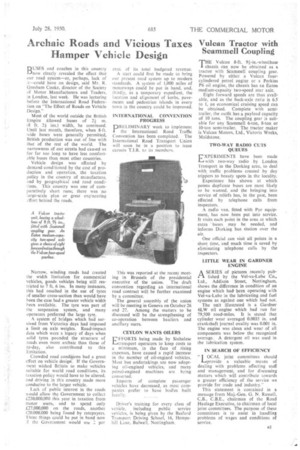MISES and coaches in this country Illnow clearly revealed the
Page 35

If you've noticed an error in this article please click here to report it so we can fix it.
effect that our road system—or, perhaps, lack of t—could have on design, said Mr. R. Gresham Cooke, director of the Society of Motor Manufacturers and Traders, in London, last week. He was lecturing before the International Road Federation on "The Effect of Roads on Vehicle Design."
Most of the world outside the British Empire allowed buses of 21 m. (8 ft. 21 ins.) width, he continued. Until last month, therefore, when 8-ft. wide buses were generally permitted, British production was out of line with that of the rest of the world. The narrowness of our streets had caused us for far too long to have less comfortable buses than most other countries.
Vehicle design was affected by demand conditioned by the cost of production and operation, the taxation policy in the country of manufacture, and by geographical and road conditions. This country was one of comparatively short runs; there was no large-scale plan or great engneering effort behind the roads.
Narrow, winding roads had created the width limitation for commercial vehicles, goods vehicles being still restricted to 7 ft. 6 ins, In many instances, this had resulted in the use of tyres of smaller cross-section than would have been the case had A greater vehicle width been available. The tyre was part of the suspension system, anti many operators preferred the large tyre.
A system of bridges which had survived from Victorian days had imposed a limit on axle weights. Road-impact data which were a legacy of days when solid tyres pounded the structure of roads even more archaic than those of to-day, also contributed to this limitation.
Crowded road conditions had a great effect on vehicle design. If the Government wished Britain to make vehicles suitable for world road conditions, its taxation policy would have to be altered, and driving in this country made more conducive to the larger vehicle.
Lack of public interest in the roads would allow the Government to collect £230,000,000 this year in taxation from motor users, and to spend only £27,000,000 on the roads, another t.220,000,000 being found by ratepayers_ Three things could be put in hand now f the Government would use 2 per cent. of its total budgeted revenue.
A start could first be made to bring our present toad system up to modern standards. A system of 1,000 miles of motorways could be put in hand, and, thirdly, as a temporary expedient, the location and alignment of kerbs, pavements and pedestrian islands in every town in the country could be improved.
INTER NATION AL CONVENTION PROGRESS
PRELIMINARY work to implement I the International . Road Traffic Convention has been completed. The International Road Transport Union will soon be in a position to issue carnets T.1.R. to its members.
This was reported at the recent meeting in Brussels of the presidential executive of the union. The draft convention regarding an international road contract will be further examined by a committee.
The general assembly of the union will be meeting in Geneva on October 26 and 27. Among the matters to be discussed will be the strengthening of co-operation between hauliers and ancillary Users.
CEYLON WANTS OILERS UFFORTS being made by Sinhalese .1—dlrartsport operators to keep costs to a minimum, in the face of rising expenses, have caused a rapid increase in the number of oil-engined vehicles. Most bus undertakings are now adopting oil-enginecl vehicles, and many petrol-engined machines are being converted.
Imports of complete passenger vehicles have decreased, as most companies prefer to have bodies built locally.
Driver's training for every class of vehicle, including public service vehicles, is being given by the Basford Transport Driving School, 16, Henipshill Lane, Bulwell, Nottingham.












































































